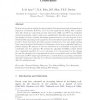134 search results - page 12 / 27 » Using Regular Tree Automata as XML Schemas |
PLANX
2007
13 years 8 months ago
2007
Although monadic second-order logic (MSO) has been a foundation of XML queries, little work has attempted to take MSO formulae themselves as a programming construct. Indeed, MSO f...
ADBIS
2010
Springer
13 years 6 months ago
2010
Springer
Abstract. As XML becomes a popular data representation and exchange format over the web, XML schema design has become an important research area. Formal Concept Analysis (FCA) has ...
ICDE
2007
IEEE
14 years 8 months ago
2007
IEEE
There has been a great deal of work in recent years on processing and optimizing queries against XML data. Typically in these previous works, schema information is not considered,...
IS
2010
13 years 5 months ago
2010
Most work on pattern mining focuses on simple data structures such as itemsets and sequences of itemsets. However, a lot of recent applications dealing with complex data like chem...
BDA
2006
13 years 8 months ago
2006
Many data on the Web are XML documents. An XML document is an unranked labelled tree. A schema for XML documents (for instance a DTD) is the specification of their internal structu...

